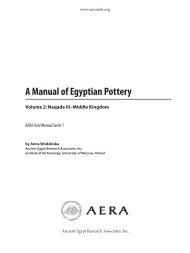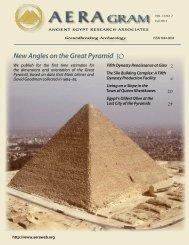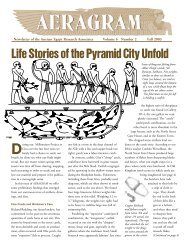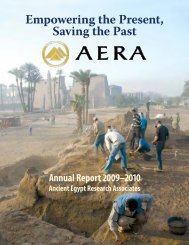The Khentkawes Town (KKT) - Ancient Egypt Research Associates
The Khentkawes Town (KKT) - Ancient Egypt Research Associates
The Khentkawes Town (KKT) - Ancient Egypt Research Associates
Create successful ePaper yourself
Turn your PDF publications into a flip-book with our unique Google optimized e-Paper software.
www.aeraweb.org<br />
lowest point of the concavity more to the south side. <strong>The</strong><br />
intent appears to have been that rainwater would flow<br />
both east and toward the south side and this is evidenced<br />
by runnels and drains that run closer to the south side.<br />
One possible channel shows in the alluvial mud paving<br />
that Hassan exposed, running roughly parallel to the<br />
southern wall of the Ramp and about 75 cm north of that<br />
wall (fig. 15).<br />
House and Fairman exposed two other channels in a<br />
shallow trench, 2 m wide, that they excavated across the<br />
width of the Ramp to look for successive paving layers,<br />
and to get the stratigraphic connections north and south.<br />
Running water might have cut the northernmost of these<br />
two channels, which trends northwest-southeast. <strong>The</strong><br />
southern channel in this surface, 20 cm lower than the<br />
Ramp surface that Hassan exposed, is better prepared. It<br />
is oriented slightly more northeast-southwest. At 30 cm<br />
wide, it is reminiscent of the Main Street channel in the<br />
settlement south of the Wall of the Crow (Abd el-Aziz<br />
2007: 123–125), flanked by a thin alluvial mud render and<br />
similarly composed over crushed marl limestone.<br />
<strong>The</strong>se channels could be clues to the meaning of the<br />
great cut or trench along the southern side of the ramp<br />
(see below).<br />
Massive Foundation<br />
We saw the foundation for the upper, western end of the<br />
Ramp in a deep excavation (NEH, fig. 16), which someone<br />
made long before our time at the northeast corner of the<br />
GIII.VT. Ana Tavares supervised the clearing and recording<br />
of this prior excavation (given the AERA feature number<br />
[29,810]) during our 2008 season.<br />
<strong>The</strong> roadbed of the Ramp continues past the entrance<br />
into the second vestibule and to the edge of the previous<br />
excavation [29,810], which cut through the Ramp and<br />
exposed layers of limestone rubble of 2.46 m combined<br />
thickness that are either an accretion holding back other<br />
material, or, more likely, the very foundation layers<br />
that people dumped to build up the Ramp (fig. 17). We<br />
investigated this point farther by dissecting these layers.<br />
<strong>The</strong> large limestone rubble of the lower layer is similar to<br />
layers filling 4 th Dynasty construction ramps elsewhere at<br />
West-facing<br />
section<br />
Figure 16. View to east showing the west-facing section of the NEH hole [29,810] at the northeast corner of the GIII.VT through the<br />
massive limestone rubble foundation of the Ramp. <strong>The</strong> mudbrick casing and limestone core blocks of the northeast corner of the<br />
GIII.VT show at lower right. <strong>The</strong> ramp passes the Vestibule entrance (upper center) and along the northern side of the GIII.VT (left).<br />
24<br />
Giza Plateau Mapping Project Season 2008 Preliminary Report











